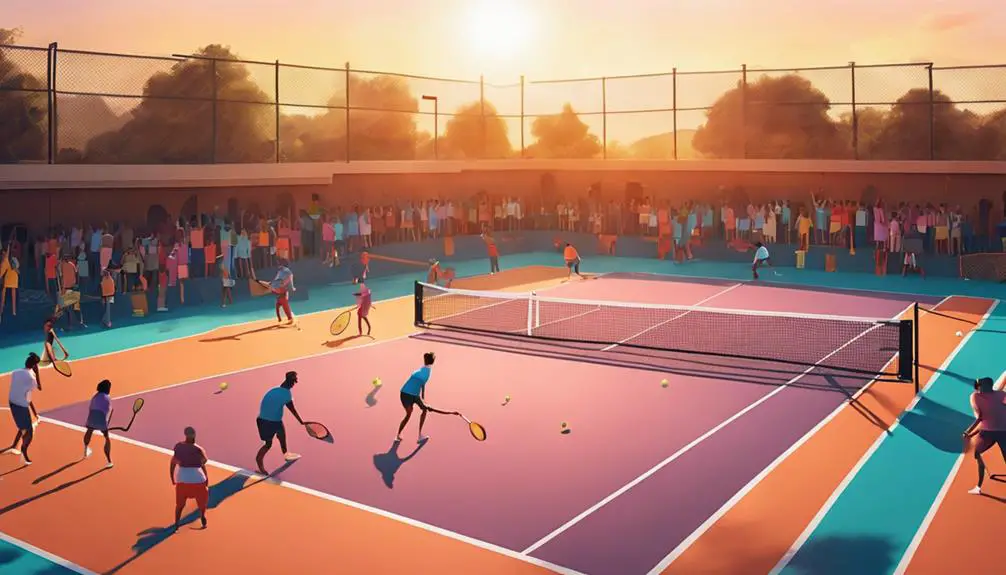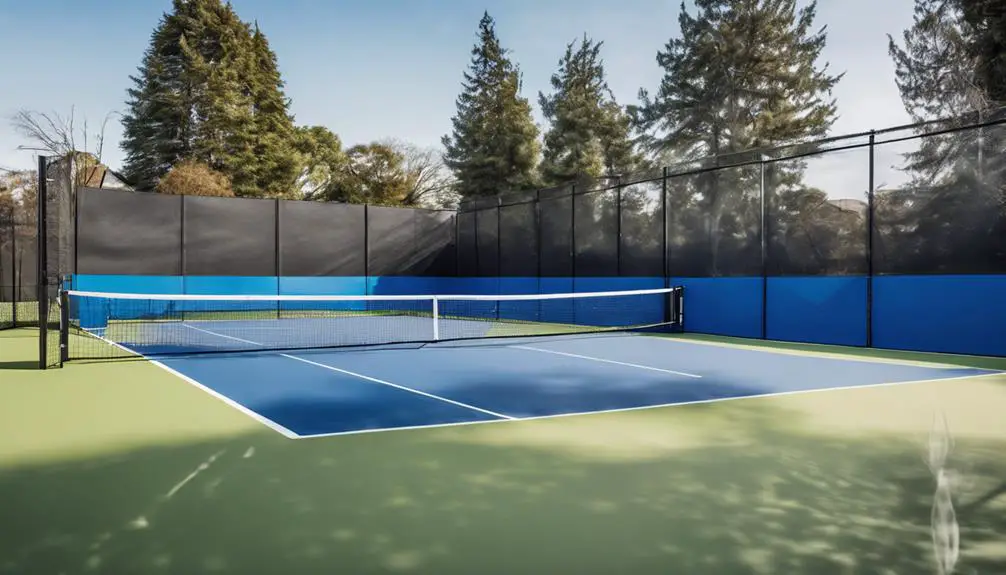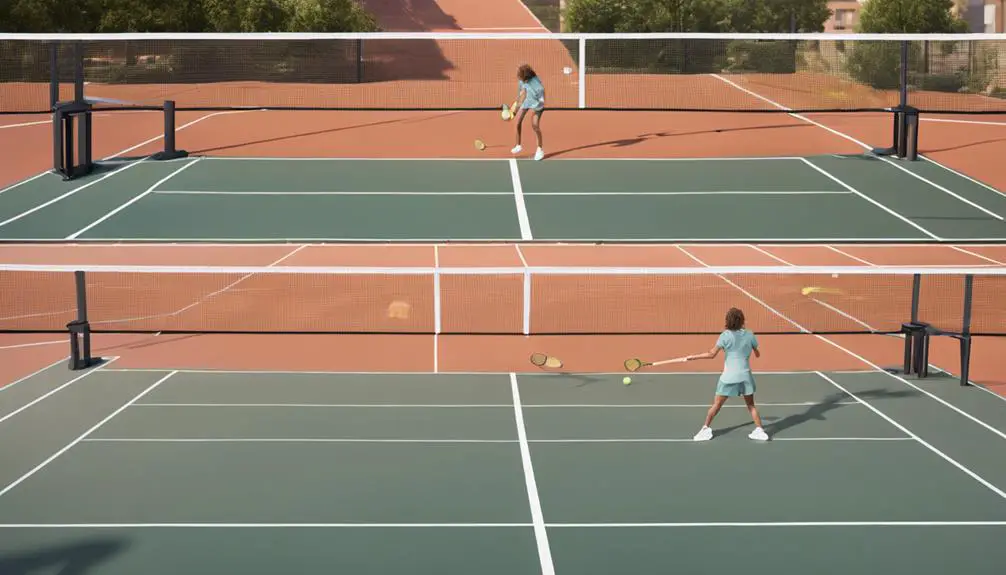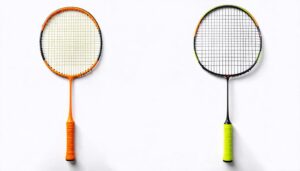When comparing paddle tennis and platform tennis, you’ll notice distinct differences that cater to varied preferences. Paddle tennis thrives in a social, relaxed atmosphere, encouraging friendly play and skill development, while platform tennis appeals more to those who enjoy competitive, high-intensity matches. The courts differ in size and design, impacting gameplay strategies. Equipment also varies, influencing how each sport feels. Both sports provide excellent physical benefits and foster community, but your choice ultimately depends on whether you crave casual fun or adrenaline-fueled competition. There’s so much more to discover about each sport’s nuances and culture.
Overview of Paddle Tennis

When you think of paddle tennis, you might picture a vibrant, fast-paced game that combines elements of traditional tennis and squash. This sport, with its unique blend of skills and strategies, has a compelling history and evolution worth exploring. Paddle tennis originated in the late 1960s in the United States, primarily as a recreational activity for families and friends. It was designed to be accessible, allowing players of all ages to enjoy the thrill of competition without the extensive physical demands of traditional tennis.
As paddle tennis gained traction, its global popularity surged, especially in countries like Spain and Argentina, where it became a staple of local sports culture. The game’s appeal lies in its simplicity and adaptability; you don’t need expansive courts or expensive equipment to play. This accessibility has fueled its growth, creating communities centered around the sport.
The evolution of paddle tennis has also seen innovations in paddle design and court size, making the game more dynamic. With its introduction to international tournaments and professional leagues, paddle tennis has transformed from a casual pastime into a serious competitive sport. As you engage with paddle tennis, whether as a player or an enthusiast, you’re part of a thriving community that celebrates freedom, camaraderie, and the love of the game. Understanding its history and evolution can deepen your appreciation for this exhilarating sport that continues to capture hearts worldwide.
Overview of Platform Tennis
Paddle tennis and platform tennis, while sharing some similarities, offer distinct experiences and characteristics that cater to different preferences among racquet sports enthusiasts. Platform tennis, often referred to as “paddle” in some regions, has a rich history that dates back to the 1920s when it was invented in the United States as a winter alternative to tennis. This sport features a unique playing environment, typically played outdoors on a raised court surrounded by screens, allowing for exciting rallies and strategic gameplay.
One of the most notable aspects of platform tennis is its growing popularity. Over the past few decades, it has surged in interest, particularly in colder climates where traditional tennis isn’t feasible year-round. You might notice that many communities are investing in platform tennis courts, fostering a vibrant social scene around the sport. The appeal lies in its accessibility—players of all skill levels can quickly learn the rules and enjoy the game, making it a favorite among recreational players and competitive athletes alike.
Popularity trends indicate that platform tennis has developed a devoted following, with numerous leagues and tournaments emerging throughout the United States. This growth reflects a broader movement toward inclusive and engaging sports that encourage community participation. As you explore platform tennis, you’ll find a sport that not only offers a thrilling challenge but also fosters camaraderie among players, making it a compelling option for anyone seeking an engaging racquet sport experience.
Court Design and Dimensions

The court design and dimensions of platform tennis are vital in shaping the unique gameplay experience that distinguishes it from other racquet sports. Unlike paddle tennis, platform tennis courts are generally smaller, measuring 44 feet long and 20 feet wide. This compact design fosters fast-paced action, requiring quick reflexes and strategic positioning. The enclosed court also includes walls, which allow players to utilize the surroundings for strategic shots, adding an exhilarating element to the game.
One significant aspect of the court is the surface materials used. Platform tennis courts are mainly constructed with a special composite material, designed to withstand harsh weather conditions while providing ideal traction. This surface allows for a unique playing experience, where ball behavior can be quite different from traditional courts. In contrast, paddle tennis courts often use asphalt or concrete, which can affect the game’s speed and ball bounce.
Additionally, net height differences play an important role in each sport’s dynamics. In platform tennis, the net stands at 34 inches in the center, which is slightly lower than the paddle tennis net. This subtle difference impacts how players approach their shots and the overall strategy they employ during matches.
Understanding these court design elements helps you appreciate the nuances of platform tennis and how they contribute to a thrilling, engaging experience. Whether you’re playing or spectating, the distinctive characteristics of the court will certainly influence your enjoyment of the game.
Equipment Differences
Exploring the equipment differences between paddle tennis and platform tennis reveals how each sport has its own unique gear tailored to enhance gameplay. When you step onto the court, you’ll quickly notice that the rackets differ greatly. Paddle tennis uses solid rackets made from composite materials, often featuring a perforated surface. This design allows for a firmer hit and better control. On the other hand, platform tennis rackets are also solid but typically have a slightly heavier frame, which contributes to a different feel and power during play.
Now, let’s talk about the balls. In paddle tennis, the balls are similar to those used in standard tennis, but they’re slightly less pressurized. This means they have a softer bounce, which can affect your strategy. Platform tennis balls, however, are uniquely designed with a specific rubber composition that allows them to withstand colder temperatures while maintaining their bounce and speed. This adaptation is essential since platform tennis is often played outdoors in winter.
Both sports require you to be mindful of your equipment, as the right racket type and ball materials can greatly influence your performance. So, whether you find yourself favoring the quick exchanges in paddle tennis or the strategic play in platform tennis, understanding these equipment differences can empower you to choose the right gear and elevate your game. Embrace the freedom to explore these variations, and you’ll find yourself better prepared for the unique challenges each sport presents.
Gameplay Rules and Objectives

Understanding the gameplay rules and objectives of paddle tennis and platform tennis can greatly enhance your experience on the court. Both sports share similarities but diverge considerably in their scoring systems and match formats, creating unique dynamics that can affect your strategy and enjoyment.
Here’s a breakdown of what you should know:
- Scoring Systems: Paddle tennis typically uses a simplified scoring system similar to tennis, where games are scored as 15, 30, 40, and game. In contrast, platform tennis often employs a more flexible scoring approach that can include variations like “no-ad” scoring, making quick points essential.
- Match Formats: In paddle tennis, matches are usually played as best-of-three sets, which can lead to longer, more strategic games. Platform tennis, however, often features shorter matches, with a focus on quick exchanges and aggressive play.
- Service Rules: Paddle tennis requires an underhand serve, while platform tennis allows for a more versatile serving style, including overhead serves, which can add an extra layer of strategy to your game.
- Court Dimensions: The court sizes differ, with platform tennis featuring a smaller playing area enclosed by screens, encouraging fast-paced rallies. Paddle tennis courts are larger, allowing for more room to maneuver and strategize.
Player Community and Culture
Both paddle tennis and platform tennis not only offer unique gameplay experiences but also foster distinct player communities and cultures that reflect their individual characteristics. When you immerse yourself in either sport, you’ll quickly notice the differences in player demographics and the types of social events that accompany them.
Paddle tennis tends to attract a younger, more diverse crowd, often characterized by a laid-back, fun-loving vibe. You’ll find players who prioritize social interaction as much as competition, often gathering for casual matches followed by lively gatherings at local courts. The community encourages inclusivity, welcoming newcomers and promoting friendly rivalries. Events like barbecues or themed tournaments are common, helping players bond over shared experiences and cultivating a vibrant social scene.
In contrast, platform tennis has a more traditional player base, often attracting enthusiasts who appreciate the sport’s strategic depth. The demographics may skew slightly older, with many players having a background in tennis or other racquet sports. The community here values competitive play, with social events often centered around league matches and organized tournaments. These events are not just about winning; they foster camaraderie and sportsmanship, providing opportunities for players to connect and share their love for the game.
In both sports, you’ll find a strong sense of community that enhances your experience, but the atmosphere and approach to social engagement can differ markedly. Whether you prefer the relaxed, festive nature of paddle tennis or the competitive yet friendly environment of platform tennis, both offer enriching player cultures that celebrate connection through sport.
Health Benefits of Each Sport

Engaging in paddle tennis or platform tennis can greatly boost your physical and mental well-being. Both sports offer unique advantages that contribute to a healthier lifestyle, and you might find yourself reaping significant rewards from either choice.
- Cardiovascular Benefits: Both sports require constant movement, which elevates your heart rate. You’ll not only build endurance but also promote heart health, reducing your risk of cardiovascular diseases.
- Muscle Engagement: Paddle tennis and platform tennis engage various muscle groups. As you serve, volley, and sprint, you’ll strengthen your core, legs, and arms, leading to improved overall muscle tone and strength.
- Stress Relief: The competitive yet social nature of these games helps you release endorphins, reducing stress levels. You’ll enjoy a fun way to clear your mind and enhance your mood while getting an excellent workout.
- Social Interaction: Engaging in these sports often means playing with friends or joining local leagues. This social aspect can improve your mental health, fostering connections and camaraderie, which are vital for emotional well-being.
Choosing the Right Game
Deciding between paddle tennis and platform tennis can feel overwhelming, but it ultimately boils down to your personal preferences and playing style. Each sport offers unique features that cater to different players. Paddle tennis is often viewed as more laid-back, making it a great choice if you enjoy a social atmosphere where you can engage with friends while honing your skills. On the other hand, platform tennis has a more competitive edge, appealing to those who thrive in high-intensity environments.
If you’re focused on skill development, consider how each game contributes to that goal. Paddle tennis allows for a variety of shots, encouraging creativity and adaptability. This can be particularly beneficial if you’re looking to improve your overall game. Conversely, platform tennis emphasizes strategy and quick reflexes, making it an excellent option if you want to sharpen your competitive instincts.
Think about your access to facilities, too. Paddle tennis courts are often found in more public parks or recreational areas, while platform tennis courts may be part of private clubs. If you’re keen on playing regularly, proximity could play a crucial role in your decision.
Ultimately, the choice between paddle tennis and platform tennis hinges on how you want to play. Whether you seek a casual game or an adrenaline-fueled match, both sports offer a rewarding experience. Embrace the freedom to explore both and see which one resonates with you!
Frequently Asked Questions
Can Children Play Paddle Tennis or Platform Tennis?
Yes, children can play both sports! Youth participation fosters social skills and teamwork. Engaging in either sport enhances skill development, allowing kids to enjoy physical activity while cultivating confidence and resilience in a fun environment.
What Are the Age Restrictions for Competitive Play in Both Sports?
In competitive leagues, age categories often range from youth to adult divisions. While specific restrictions vary, most organizations allow participation from around age 8, ensuring everyone can experience the joy of competitive play at their own level.
How Do Weather Conditions Affect Each Sport’s Playability?
You might think weather’s just a minor factor, but it greatly impacts playability. Court surfaces react differently to rain or heat, and equipment differences can influence performance, so always consider conditions before heading out to play.
Are There Professional Tournaments for Paddle Tennis and Platform Tennis?
Yes, both sports feature professional tournaments with structured formats and player rankings. These events foster competition and showcase talent, giving you the chance to witness thrilling matches while players endeavor for recognition and advancement in their careers.
What Are the Most Common Injuries in Paddle Tennis Versus Platform Tennis?
You’ve seen players suffer ankle sprains from quick directional changes or shoulder injuries from powerful serves. In both sports, these injuries are common due to intense movements, emphasizing the need for proper conditioning and preventive measures.




